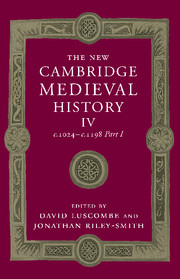Book contents
- Frontmatter
- 1 Introduction
- 2 The Rural Economy and Demographic Growth
- 3 Towns and the Growth of Trade
- 4 Government and Community
- 5 The Development of Law
- 6 Knightly Society
- 7 War, Peace and the Christian Order
- 8 The Structure of the Church, 1024–1073
- 9 Reform and the Church, 1073–1122
- 10 Religious Communities, 1024–1215
- 11 The Institutions of the Church, 1073–1216
- 12 Thought and Learning
- 13 Religion and the Laity
- 14 The Crusades, 1095–1198
- 15 The Eastern Churches
- 16 Muslim Spain and Portugal: Al-Andalus and its Neighbours
- 17 The Jews in Europe and the Mediterranean Basin
- 18 Latin and Vernacular Literature
- 19 Architecture and the Visual Arts
- List of Primary Sources
- Bibliography of secondary works arranged by chapter
- Index
- Frontispiece">
- Plate section"
- References
14 - The Crusades, 1095–1198
Published online by Cambridge University Press: 28 March 2008
- Frontmatter
- 1 Introduction
- 2 The Rural Economy and Demographic Growth
- 3 Towns and the Growth of Trade
- 4 Government and Community
- 5 The Development of Law
- 6 Knightly Society
- 7 War, Peace and the Christian Order
- 8 The Structure of the Church, 1024–1073
- 9 Reform and the Church, 1073–1122
- 10 Religious Communities, 1024–1215
- 11 The Institutions of the Church, 1073–1216
- 12 Thought and Learning
- 13 Religion and the Laity
- 14 The Crusades, 1095–1198
- 15 The Eastern Churches
- 16 Muslim Spain and Portugal: Al-Andalus and its Neighbours
- 17 The Jews in Europe and the Mediterranean Basin
- 18 Latin and Vernacular Literature
- 19 Architecture and the Visual Arts
- List of Primary Sources
- Bibliography of secondary works arranged by chapter
- Index
- Frontispiece">
- Plate section"
- References
Summary
the proclamation of the First Crusade at Clermont by Pope Urban II on 27 November 1095 was marked by the flamboyance which was a feature of his year-long journey through France. A church council, attended by some 200 archbishops, bishops and abbots, was ending. Urban had asked the bishops to bring the leading nobles in their dioceses with them to the council. The invitation had not been very successful and few lay notables from regions other than Auvergne were present. Although winter was approaching, the gathering was mustered out of doors in a field just outside the town. There are conflicting eye-witness accounts of the pope’s sermon and of the events that immediately followed, but it is clear that the conclusion of the sermon was the signal for extravagant and obviously prearranged gestures of acceptance made by senior churchmen.
The casus belli had been provided by the invasion and occupation of most of Asia Minor by the Turks. The loss of their eastern territories and the threat posed to Constantinople had persuaded the Byzantine emperors to appeal for help from the popes and leading laymen in the west, and in 1074 Pope Gregory VII had proposed that he himself lead an army of 50, 000 men to the east. In 1089 and 1091 Urban may already have been considering calling for French and perhaps other volunteers to fight for the Greeks, and in 1090 Count Robert I of Flanders, perhaps in response to a Byzantine initiative, had entered into an agreement to serve the empire with 500 knights for pay. In March 1095, while Urban was preparing for his visit to France and was presiding over a church council at Piacenza, a new appeal had reached him.
- Type
- Chapter
- Information
- The New Cambridge Medieval History , pp. 534 - 563Publisher: Cambridge University PressPrint publication year: 2004
References
- 2
- Cited by

